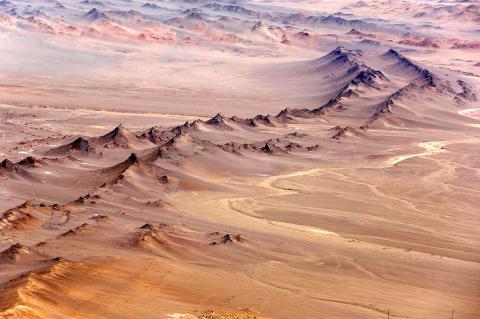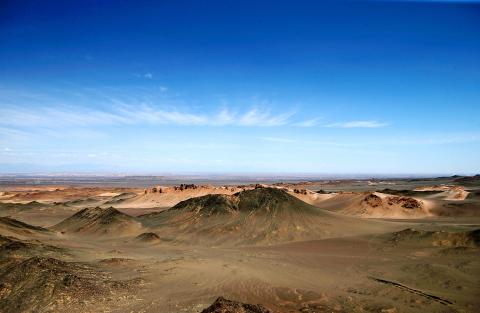The Tengger Desert lies on the southern edge of the massive Gobi Desert, not far from major cities like Beijing. The Tengger is growing.
For years, China’s deserts spread at an annual rate of more than 4,000km2. Many villages have been lost. Climate change and human activities have accelerated the desertification. China says government efforts to relocate residents, plant trees and limit herding have slowed or reversed desert growth in some areas. But the usefulness of those policies is debated by scientists, and deserts are expanding in critical regions.
BIG DESERT GETTING BIGGER

Photo: AFP
Nearly 20 percent of China is desert, and drought across northern China is getting worse. One recent estimate said China had 54,400km2 more desert than what existed in 1975 — about the size of Croatia. As the Tengger expands, it is merging with two other deserts to form a vast sea of sand that could become uninhabitable.
Across northern China, generations of families have made a living herding animals on the edge of the desert. Officials say that along with climate change, overgrazing is contributing to the desert’s growth. But some experiments suggest moderate grazing may actually mitigate the effects of climate change on grasslands, and China’s herder relocation policies could be undermining that.
In an area called Alxa League, the government has relocated about 30,000 people, who are called “ecological migrants,” because of desertification.

Photo: AFP
Officials have given Liu Jiali, 4, and her family a home in a village about 10km from Swan Lake, the oasis where they run a tourist park. To get them to move and sell off their herd of more than 70 sheep, 30 cows and eight camels, the officials have offered an annual subsidy equivalent to US$1,500 for each of her parents and US$1,200 for a grandmother who lives with them.
Jiali’s mother, Du Jinping, 45, said the family would live in the new village in the winter, but return to Swan Lake in the summer.
Local governments in desert regions began relocating people away from the encroaching sands decades ago. But China’s densely populated areas are pushing toward the deserts, as the deserts grow toward the cities.

Photo: AFP
Storms of wind-driven sand have become increasingly frequent and intense, reaching Beijing and other large cities. “We dread the sandstorms,” Du said.
Residents who live on the edge of the deserts try to limit the steady march of the sand. Along with local governments, they plant trees in an effort to block the wind and stabilize the soil.
Many people in this area are from families that fled Minqin, at the western end of the Tengger Desert, during China’s Great Famine from 1958-62, when tens of millions died.
Guo Kaiming, 40, a farmer who also manages a tourist park at the edge of the Tengger Desert, planted rows of trees by a new cross-desert highway in June.
Guo took saplings the government had left behind after it completed a tree planting operation. He said he was not ready to join the climate refugees. He has his corn and wheat fields, plus income from running the tourist park.
Last year, the company that runs the park paid students to build seven giant sand sculptures as its centerpiece. But strong desert winds steadily eroded them.
“They are all a mess now,” Guo said. “The wind is fierce.”
RECLAIMING THE DESERT
The government encourages farmers like Guo because, it says, agriculture can help reclaim land from the desert. Officials offer subsidies: Guo gets US$600 per year for “grassland ecological protection.”
But farming is also becoming more difficult. Huang Chunmei, who grew up in the town of Tonggunao’er and now farms there, said the water table was 2 meters below ground during her childhood, and “now, you have to dig 4 or 5 meters.”
Huang planted more than 200 trees on her own last spring, in the hope that they would help block sandstorms and hold back the sand.
“The soil is not as soft or good as it was before,” she said. “We use more fertilizer now.”
Huang and her husband have sent their 14-year-old daughter to a boarding school in a nearby city.
“I don’t want my girl to return,” she said. “The sand and wind make life tough here.”
About 17 percent of the population in Alxa League are ethnic Mongolians, whose lives and livelihoods have long been tied to the herding the government is trying to halt.
Mengkebuyin, 42, and his wife, Mandula, 41, grow corn and sunflowers, but their 200 sheep provide most of their income: They sell the meat to a hotel restaurant in a nearby city.
The sheep graze in the desert, where grass is growing scarce. They roam near his old family home, near the shores of a lake that dried up years ago. He would like to move to better pasture, but the government will not let him. Mengkebuyin and his wife maintain the old home but do not stay for long periods. They have moved to a village 5 miles away.
Mengkebuyin and Mandula have decided that they want their 16-year-old daughter to live and work in a city.
Four generations of Mengkebuyin’s family lived by the lake in a thriving community. But gradually, everyone left.
The desert has taken over.

That US assistance was a model for Taiwan’s spectacular development success was early recognized by policymakers and analysts. In a report to the US Congress for the fiscal year 1962, former President John F. Kennedy noted Taiwan’s “rapid economic growth,” was “producing a substantial net gain in living.” Kennedy had a stake in Taiwan’s achievements and the US’ official development assistance (ODA) in general: In September 1961, his entreaty to make the 1960s a “decade of development,” and an accompanying proposal for dedicated legislation to this end, had been formalized by congressional passage of the Foreign Assistance Act. Two

Despite the intense sunshine, we were hardly breaking a sweat as we cruised along the flat, dedicated bike lane, well protected from the heat by a canopy of trees. The electric assist on the bikes likely made a difference, too. Far removed from the bustle and noise of the Taichung traffic, we admired the serene rural scenery, making our way over rivers, alongside rice paddies and through pear orchards. Our route for the day covered two bike paths that connect in Fengyuan District (豐原) and are best done together. The Hou-Feng Bike Path (后豐鐵馬道) runs southward from Houli District (后里) while the

March 31 to April 6 On May 13, 1950, National Taiwan University Hospital otolaryngologist Su You-peng (蘇友鵬) was summoned to the director’s office. He thought someone had complained about him practicing the violin at night, but when he entered the room, he knew something was terribly wrong. He saw several burly men who appeared to be government secret agents, and three other resident doctors: internist Hsu Chiang (許強), dermatologist Hu Pao-chen (胡寶珍) and ophthalmologist Hu Hsin-lin (胡鑫麟). They were handcuffed, herded onto two jeeps and taken to the Secrecy Bureau (保密局) for questioning. Su was still in his doctor’s robes at

Mirror mirror on the wall, what’s the fairest Disney live-action remake of them all? Wait, mirror. Hold on a second. Maybe choosing from the likes of Alice in Wonderland (2010), Mulan (2020) and The Lion King (2019) isn’t such a good idea. Mirror, on second thought, what’s on Netflix? Even the most devoted fans would have to acknowledge that these have not been the most illustrious illustrations of Disney magic. At their best (Pete’s Dragon? Cinderella?) they breathe life into old classics that could use a little updating. At their worst, well, blue Will Smith. Given the rapacious rate of remakes in modern